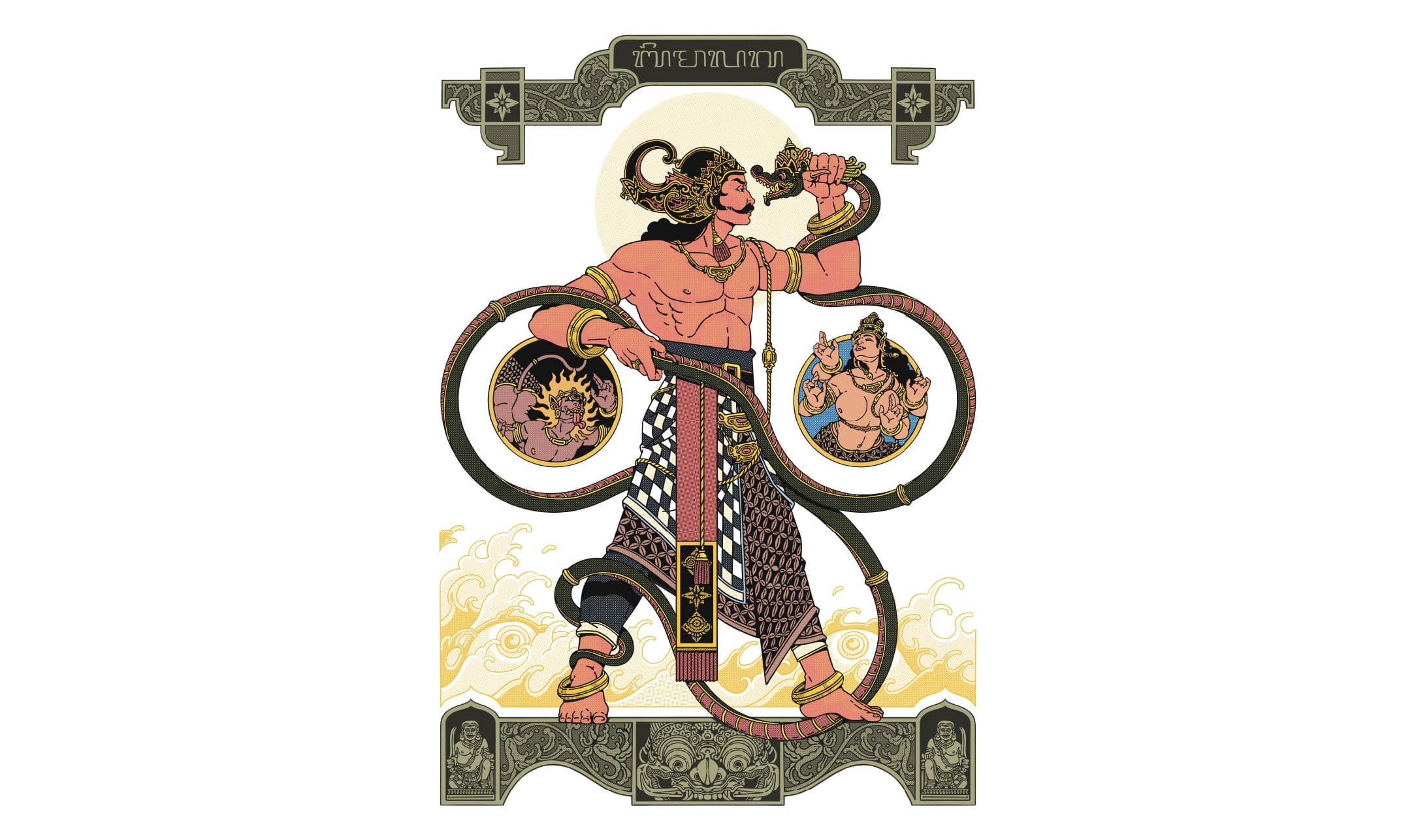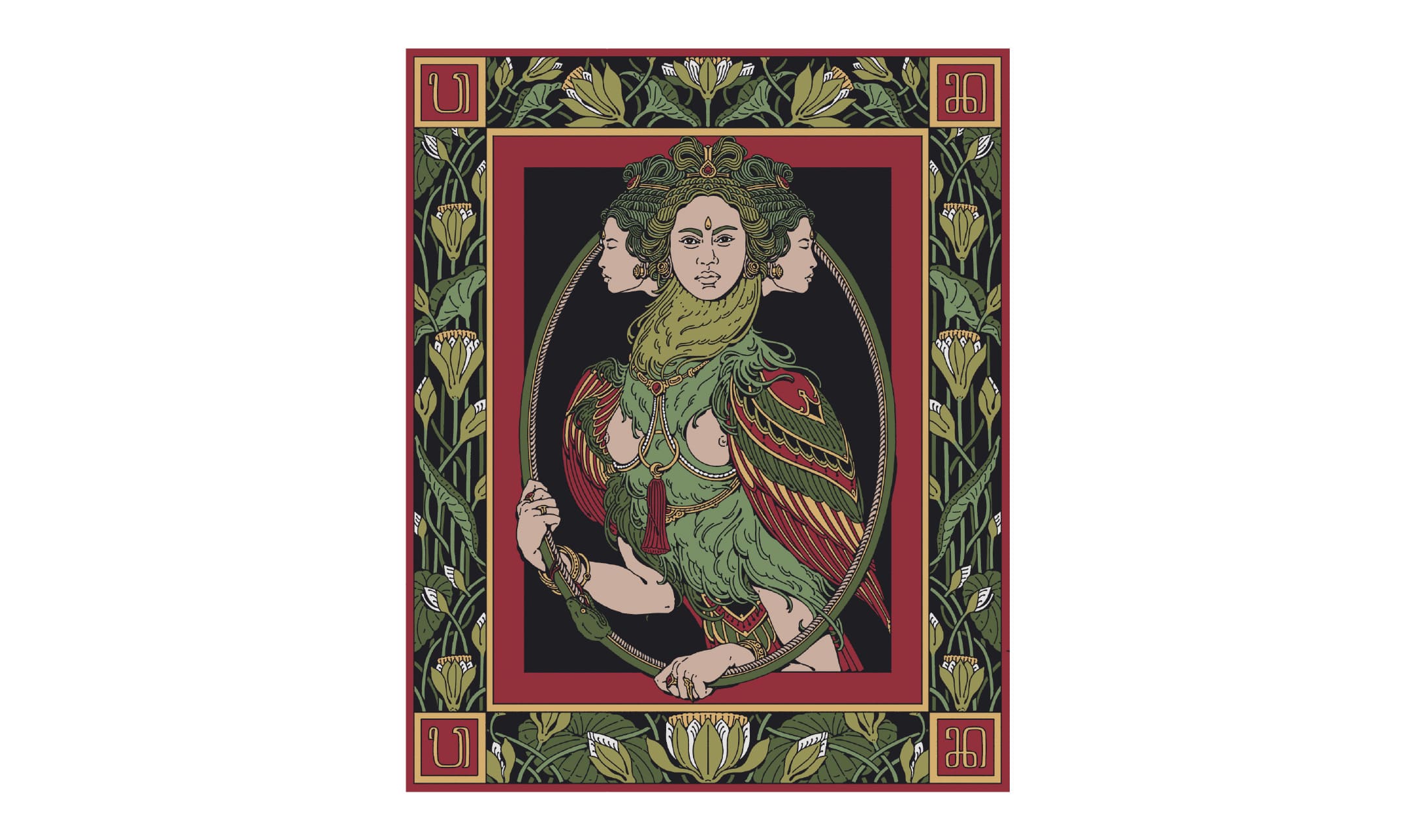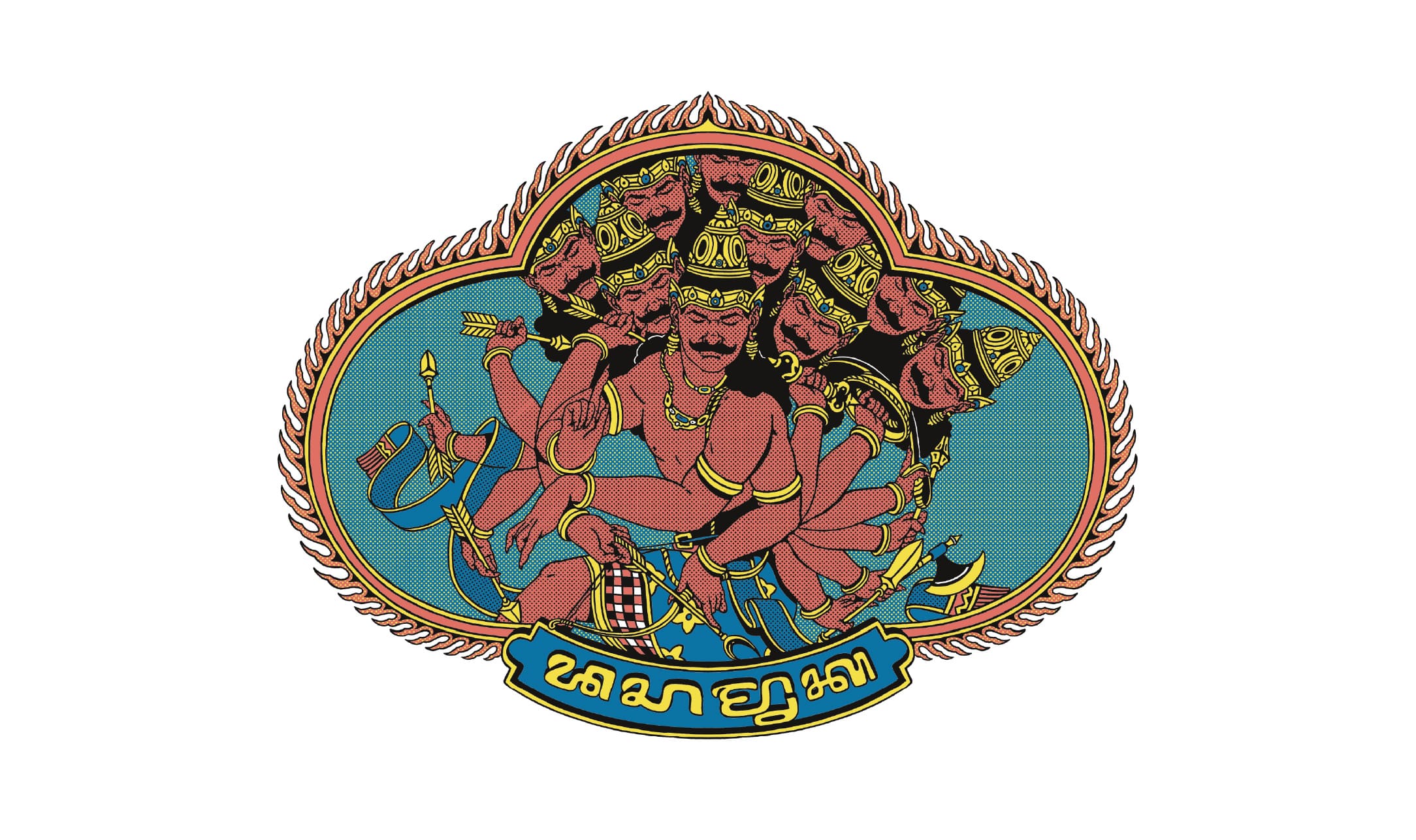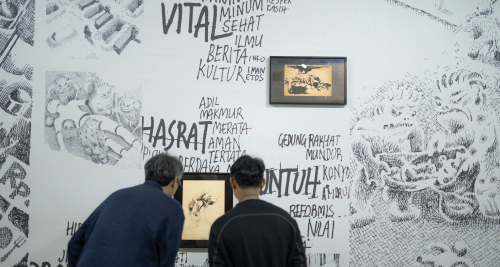Gusde Sidhi: Local Narratives in Modern Ornamentation
“The first stroke doubled into two, then three, four, and so on, from an abstract line turning into the form of a winged lion relief,” recalled Gusde Sidhi. He is an illustrator from Bali whose works often present a blend of local narratives with modern aesthetics. Figures from Balinese mythology and history appear through visual styles influenced by Art Nouveau, comics, and contemporary graphic design. Bold curving lines, dense ornamental details, and colors processed to resemble the texture of old prints are recurring elements in his work.
Gusde’s journey into illustration began with this simple moment. He remembered being around four or five years old, sitting with his cousins and watching his father draw a replica of a winged lion relief from a gedong, a traditional Balinese building. Although mesmerized, he admitted he never thought about the moment again, nor did he try to draw on his own.
As a child, he was far more familiar with storytelling than drawing. His grandfather, father, and sister were all storytellers. His grandfather often shared his experiences as a romusha laborer and as a witness to the PKI tragedy, sometimes inserting these stories between performances of wayang Cenk Blonk (a Balinese shadow puppet theater mixed with contemporary comedy) that the family listened to on the radio. His father told stories while riding his old Vespa, narrating the legends and myths of every place they passed. His sister loved reading him a worn-out book of folktales over and over again. “Because of this habit, I once dreamed of becoming a dalang (puppet master) and completely forgot about drawing,” he said.

Gusde started drawing regularly in elementary school, not out of passion, but because his teacher encouraged him to enter competitions. He went from one contest to another, winning several up to the district level. He also drew for school organizations and even offered small portrait commissions for his classmates. All of this, he admitted, was done without seriousness. A turning point came at the end of high school. “Maybe out of boredom, I began drawing the folktales and historical stories I loved. That was when I found my passion for drawing, when I used it to tell stories,” he said. From that point, he decided to take drawing seriously and pursued a degree in design.
In 2016, he entered the Indonesian Institute of the Arts Denpasar (now ISI Bali), hoping to deepen his skills in illustration. Since then, Gusde has had a habit of researching the people behind works he admires. If he found an artwork on Instagram, he would track down the artist, explore their portfolio, visit their website, read interviews, and collect everything in a catalog pinned on Pinterest. This habit built a vast visual library that became the foundation for his exploration. References ranged from Rio Sabda, Kendra Paramita, Hari Merdeka, Sweta Kartika, and Monez, to Yuko Shimizu, Victo Ngai, and JC Leyendecker. He experimented with comic strips, webtoons, commercial illustrations, and editorial posters. From these trials, his path became clearer.
Opportunities began to unfold. He interned with Monez, then worked as an illustrator at Florto Studio, Monez’s design studio. Through this, he connected with graphic art communities like Binatang Press and Knuckles and Notch, and later collaborated with major brands including Uniqlo, Palari, Bodrex, Giordano, and Adidas. In 2023, he was commissioned to create the welcoming poster for Coldplay’s “Music of the Spheres” concert in Jakarta.
Now, after five years as a professional illustrator, Gusde reflected on his rapid progress. “This achievement feels fast, and of course it would have been impossible without the generosity and countless strokes of luck,” he admitted. With illustration as his established profession, he now finds himself yearning to explore new mediums. “What medium will it be? Honestly, I don’t know yet, maybe I’ll share that story another time.”
Initially, Gusde worked with traditional tools such as paper, colored pencils, and watercolor. However, since university, he has focused on digital drawing. The reason, he explained, was simple: “It’s more versatile for my profession as an illustrator.”
His works are often identified with Art Nouveau aesthetics. He does not reject this reading, as JC Leyendecker and Alphonse Mucha were major influences. Still, he pointed out that many others shaped his vision, including Yuko Shimizu, Victo Ngai, Raul Urias, Rudolf Bonnet, Le Mayeur, Miguel Covarrubias, Cornelis Jetses, Dean Cornwell, Hendrick Goltzius, and Shintaro Kago, as well as numerous artists from the 18th to 20th centuries. “That’s why I never try to define my style. For me, what I want to convey comes first, and the style follows,” he said.
In his process, Gusde always begins with the message he wants to communicate. For commercial projects, the message comes from the client. For personal works, inspiration often comes from the books, films, and music he consumes. When asked about the tendency to merge Art Nouveau with local touches, he answered plainly. “Maybe it comes from the visual references I absorb. If asked what I want to express, I think I just want to remember local stories, mostly from Bali, with visuals that suit my taste.”
Among his projects, Gusde mentioned three that challenged him the most. One was his collaboration with Adidas, where he was asked to design a T-shirt featuring Balinese iconography. Although he had received similar briefs before, this time he wanted to present something different. “I decided to show Balinese iconography in an Art Deco style. I tried to bring out an image that was graceful, elegant, but still strong and sporty,” he explained.
The second was the Coldplay poster in 2023. Although distributed in limited circulation, the sheer size of Coldplay’s global audience put considerable pressure on him. The third was his collaboration with Binatang Press and Knuckles and Notch, where he experimented with risograph printing for the first time. “I was completely unfamiliar with riso before this project. The opportunity to collaborate with these two studios was both challenging and enjoyable,” he said.
This year, Gusde is featured as an official artist at the Jakarta Illustration and Creative Arts Festival (JICAF) 2025. For the festival, he has prepared explorations in new media, including tapestry, pins, and ceramic pendants. “There are many more experiments that unfortunately have not materialized for JICAF this year, but hopefully I’ll have the chance again next year,” he said.
Reflecting on the state of illustration in Indonesia today, Gusde sees both promise and challenges. “Recently, illustration in Indonesia has become highly popular. Many new illustrators with fresh visuals are emerging,” he said. But he also noted an irony. “This surplus of talent faces a shrinking job market, partly due to AI and the global economic slowdown.”
Even so, he sees a new horizon of hope in the rise of art markets and fairs. “Events like JICAF give us fresh air and hope, or at least open our eyes as illustrators, that our opportunities don’t stop at offering services. We can also sell finished products directly to our audience,” he said.
“This is a critical moment for the illustration world. Since luck is beyond our control, the ability to hunt for opportunities is the only way to survive,” he concluded.


















